Iles Evangeline: Difference between revisions
Tag: 2017 source edit |
m (→History) Tag: 2017 source edit |
||
| (17 intermediate revisions by the same user not shown) | |||
| Line 106: | Line 106: | ||
}} | }} | ||
'''Iles Evangeline''', officially the '''Candidate Jurisdiction for [[Government_of_Burgundie#Constituent_Countries|BORA]] Inclusion of Iles Evangeline''' is a territory of [[Burgundie]]. Previously owned by [[Varshan]] which governed it as part of its Shauku Islands Province until its forces were expelled in [[2021]] by a joint | '''Iles Evangeline''', officially the '''Candidate Jurisdiction for [[Government_of_Burgundie#Constituent_Countries|BORA]] Inclusion of Iles Evangeline''' is a territory of [[Burgundie]]. Previously owned by [[Varshan]] which governed it as part of its Shauku Islands Province until its forces were expelled in [[2021]] by a joint [[Iles Evangeline#Final War of the Deluge|Daxo-Alstinian invasion]] after which it was transferred to [[Daxia]]ese control before being sold to [[Burgundie]] in [[2028]]. | ||
==Etymology== | ==Etymology== | ||
Named for [[Crown Princess Amelia]]. | Named for [[Crown Princess Amelia]]. | ||
| Line 137: | Line 138: | ||
==History== | ==History== | ||
=== | ===Prehistory=== | ||
{{Further|Timeline_of_major_world_events#Prehistory}} | |||
<gallery mode="packed"> | |||
File:Dugout_Canoe_Excavated_at_Kuahuqiao_Site_of_Hangzhou_02_2014-07.JPG|8000 yr old dug out canoe | |||
</gallery> | |||
Archeological evidence suggests that the [[Shauku Archipelago]] was settled around 800,000 years ago by hunter-gatherer peoples who made use of stone and clamshell tools. These people had a mostly plant-based diet with monkey and fish flesh entering their repertoire around 50,000 years ago. Agriculture is first recorded around 15,000 years ago, but it was light due to the thick jungle vegetation. Domesticated dogs and pigs were also evidenced in this period as well. In the 4th century BCE, with the introduction of rudimentary sail technology, to the paddled dugout canoes used by the islanders, the outer islands of the [[Shauku archipelago]] became settled. There was light Oyashimane settlement since roughly 200 BC. | |||
===Classical Antiquity=== | |||
{{Further|Timeline_of_major_world_events#Classical_Antiquity}} | |||
<gallery mode="packed"> | |||
File:2006_01_21_Athènes_Parthénon.JPG | |||
File:Alexander_and_Bucephalus_-_Battle_of_Issus_mosaic_-_Museo_Archeologico_Nazionale_-_Naples_BW.jpg | |||
</gallery> | |||
Words, words, words. (9th century BC-5th century AD, exact dates determined by you to fit your lore) | |||
===Medieval period=== | |||
{{Further|Timeline_of_major_world_events#Medieval_history}} | |||
<gallery mode="packed"> | |||
File:Canterbury_Cathedral,_window_nXV_detail_(46220634195).jpg | |||
File:SiegeofAntioch.jpeg | |||
</gallery> | |||
Words, words, words. (6th century - early 16th century, exact dates determined by you to fit your lore) | |||
===Early modern history=== | |||
{{Further|Timeline_of_major_world_events#Early_modern_history}} | |||
<gallery mode="packed"> | |||
File:Westfaelischer_Friede_in_Muenster_(Gerard_Terborch_1648).jpg | |||
File:A_Castro,_Lorenzo_-_A_Dutch_East-Indiaman_off_Hoorn_-_Google_Art_Project.jpg | |||
</gallery> | |||
===Far East Colony=== | ===Far East Colony=== | ||
[[File:Far East Colony Max Extent map.png|250px|right]] | [[File:Far East Colony Max Extent map.png|250px|right]] | ||
{{Further|Far East Colony}} | {{Further|Far East Colony}} | ||
===Varshan conquest=== | ===Late modern period=== | ||
{{Further|Timeline_of_major_world_events#Late_modern_history}} | |||
<gallery mode="packed"> | |||
File:Trencheswwi2.jpg | |||
File:AmericanAndSovietAtElbe.jpg | |||
</gallery> | |||
===Varshan conquest and rule=== | |||
{{Further|Shauku Archipelago#Varshan conquest of the Shauku Archipelago}} | |||
Following the abandonment of the [[Far East Colony]] in [[1817]] by the [[Burgoignesc Kandahar-Kandara Trading Company|Marialanii Ularien Trading Company]] the native Oyashi daimyos and ambitious Matsutori mainlanders formed various factions and started fighting to control the territory. One such faction was the [[Oyashima#Republic_of_Matsumori|Republic of Matsutori]], a short-lived [[Occidental]]-inspired republic beset by domestic political divisions and ethnic tensions, and foreign territorial encroachments and diplomatic pressure. | |||
During the 1850s, under the of command the Zurg Tezomoc, Varshan initiated a multiyear-long naval expedition to the [[Shauku Archipelago]], thoroughly defeating the [[Oyashima#Republic_of_Matsumori|Matsutorine]] forces in the region and rendering [[Oyashima#Republic_of_Matsumori|Matsutorine]] control over the islands unfeasible. With the conquest of the [[Shauku Archipelago|archipelago]], Varshan had a foothold in the Far East of [[Audonia]] and would occupy the islands for the next 170 years. | |||
===Contemporary period=== | |||
{{Further|Timeline_of_major_world_events#Contemporary_history}} | |||
<gallery mode="packed"> | |||
File:Berlin_Wall_1961-11-20.jpg | |||
File:LYF_WATER_2_Smartphone.JPG | |||
</gallery> | |||
====Contemporary Varshani rule==== | |||
====Daxo-Alstinian invasion of the Shauku Archipelago==== | |||
{{Further|Final War of the Deluge}} | |||
<gallery mode="packed"> | |||
File:PLANS_Changbai_Mountain_(LSD-989)_20150826_3.jpg|Daxian amphibious transport dock passing a sunk Varshani frigate on its final approach to its landing zone. | |||
File:PLANS_Yunwu_Mountain_(LPD-997)_20150825.jpg|Daxian landing craft resupplying a beachhead on April 13th, [[2021]]. | |||
</gallery> | |||
The Battle of the Shauku Islands was an ancillary engagement during the [[Final War of the Deluge]], fought between March and May of [[2021]]. The [[Varshan]]i naval contingent on the [[Shauku Archipelago]] was considered a liability as it could attack from the rear during the ground invasion of [[Varshan]] proper and the allied command determined that it needed to be eliminated. The combined forces of [[Daxia]] and [[Alstin]], were tasked to launched an invasion of the archipelago. | |||
The invasion commenced on March 3rd, with a massive naval battle, the ''First Battle of the Shauku Littoral''. The [[Daxia]]n fleet approached from their southwest stronghold in [[Cao]] and the [[Alstin]]ian fleet arrived from their northwest bases in [[Oyashima]]. The [[Varshan]]i navy, caught off guard by the scale and coordination of the attack, engaged in a fierce but ultimately losing battle, after a two-day running battle, the remaining ships of the [[Varshan]]i navy, limped out into the [[Great Expanse]]. The [[Daxia|Daxo]]-[[Alstin]]ian forces were able to establish temporary naval dominance of the [[Shauku Archipelago|Shauku littoral]], initiating a relentless bombardment of the islands' defenses. | |||
With the [[Varshan]]i navy crippled and coastal defenses weakened, [[Daxia|Daxo]]-[[Alstin]]ian forces initiated amphibious landings across the archipelago. The initial landings met with fierce resistance from the Varshani defenders, who were determined to protect the islands. Despite heavy casualties on both sides, the [[Daxia|Daxo]]-[[Alstin]]ian forces, aided by continuous naval and aerial bombardment, were able to secure small beachheads and begin pushing inland by March 17th. The Varshani defenders used the jungle terrain and guerrilla tactics to launch numerous counterattacks against the [[Daxia|Daxo]]-[[Alstin]]ian beachheads. The [[Daxia|Daxo]]-[[Alstin]]ian forces experienced significant setbacks throughout the week of the 21st, with some units being forced back into the sea. In response to the Varshani counterattacks, the [[Daxia|Daxo]]-[[Alstin]]ian forces intensified their aerial and naval bombardment. The islands' infrastructure, already heavily damaged by the initial assault, was systematically destroyed. The bombing campaign caused widespread devastation and significant civilian casualties, but it also severely weakened the Varshani defenses and made command and control communications extremely difficult, rendering coordinated operations almost impossible. During the first week of April, a number of resupply convoys arrived and the [[Daxia|Daxo]]-[[Alstin]]ian forces, reinforced and resupplied, renewed their amphibious assaults, determined to gain control of the beaches. The Varshani defenders, although disorganized, lacking a functional central command and depleted of resources and ammunition, continued to resist fiercely. After weeks of bloody fighting, the [[Daxia|Daxo]]-[[Alstin]]ian forces eventually managed to secure the beaches, establishing a firm foothold on the major islands. With the beaches secured, the [[Daxia|Daxo]]-[[Alstin]]ian forces began their advance inland. The Varshani defenders, now fighting a desperate rearguard action, retreated into the interior, using the ruined infrastructure to their advantage to confound [[Daxia|Daxo]]-[[Alstin]]ian armored manevers and to conduct ambushes. The fighting was sometimes even hand-to-hand, with the [[Daxia|Daxo]]-[[Alstin]]ian forces suffering heavy losses. As the [[Daxia|Daxo]]-[[Alstin]]ian forces advanced throughout the second week of April, the Varshani navy returned and launched a series of counterattacks in an attempt to disrupt the invasion. These attacks, the ''Second Battle of the Shauku Littoral'', although initially successful in distracting the [[Daxia|Daxo]]-[[Alstin]]ian advance, were ultimately repelled, with the Varshani navy fighting to the last vessel and aircraft. The battle ended on April 25th when the last of the Varshani submarines was hunted down and destroyed. Despite the setbacks and heavy casualties, the [[Daxia|Daxo]]-[[Alstin]]ian forces relentlessly pursued the remaining Varshani defenders on land. The fighting continued for two more weeks, with the Varshani forces gradually being isolated and killed. Eventually, after 9 weeks of intense combat, the last Varshani strongholds were overrun, and the islands were declared secure. | |||
In the aftermath, [[Daxia]] and [[Alstin]] divided the archipelago between them. The southern islands, fell under [[Alstin]]ian control and the northern islands were occupied by [[Daxia]]. The Alstinians quickly established a military administration in their sector, focusing on restoring order and rebuilding infrastructure. They invested in the islands' agricultural lands and established naval bases to protect their trade routes and project power into [[Audonia]]. The initial occupation was met with pockets of resistance, with a guerrilla movement, comprised of former Varshani soldiers and disgruntled civilians, launching sporadic attacks against [[Alstin]]ian forces and infrastructure projects. The [[Daxia]]ns prioritized the exploitation of the islands' mineral wealth, establishing mining operations and industrial complexes. They also constructed military fortifications, transforming the northern islands into a formidable bulwark against potential Varshani counterattacks. They forcibly deported the vast majority of the [[Vasrhan]]i almost immediately and have few cases of resistance | |||
===Daxian military rule=== | ===Daxian military rule=== | ||
A joint naval invasion by Alstinian and Daxian forces pushed Varshan's forces from the islands and brought an end to its rule there. A period of popular resistance driven by Arzalist priests followed. The Daxian military enacted brutal mass reprisals and deportations that however | A joint naval invasion by Alstinian and Daxian forces pushed Varshan's forces from the islands and brought an end to its rule there. A period of popular resistance driven by Arzalist priests followed. The Daxian military enacted brutal mass reprisals and deportations that however succeeded in quieting down the situation. Civilian [[Varshan]]i administrators were summarily dismissed, Arzalist shrines shuttered and all public gatherings of over three people prohibited. Whatever produce was imported from the mainland was requisitioned by the army to supplement its rations, the locals were introduced to a new diet consisting of disgusting [[Daxian Aspic|aspic]] food rations courtesy of [[Agario]]. Four months after introduction, there was a riot at a food distribution center in which twenty tons of aspic rations were set on fire. Daxian rule of the unruly islanders was becoming more expensive and less advantageous than previously thought. | ||
===Handover to Burgundie=== | ===Handover to Burgundie=== | ||
Liyu, was transferred to [[Burgundie|Burgoignesc]] administration on | Liyu, was transferred to [[Burgundie|Burgoignesc]] administration on November 17th, [[2028]] as a reparation for the [[Battle_of_Ayermer_(1936)|loss]] of [[Cheun|Ayermer]] during the [[Second Great War]] which until that point had remained a major sticking point in the relationship between [[Burgundie]] and [[Daxia]] to the point that both countries, as a matter of administrativia, remained technically at war until the handover of Liyu and the signing of the Instrument of the Formalization of the Cessation of Hostilities Stemming from the Global Conflicts of the 1930s and 1940s. | ||
A respectful ceremony between outgoing District Chief, Gong Farbo, and incoming Prefect Plenipotentiary, Rachelle-Evangeliste Vanchamps d'Elisioile and their retinues of diplomats, marines, sailors, and administrative personnel after which its name was changed to [[Iles Evangeline]] after [[Crown Princess Amelia]], of [[Burgundie]] who helped to broker the deal. | A respectful ceremony between outgoing District Chief, Gong Farbo, and incoming Prefect Plenipotentiary, Rachelle-Evangeliste Vanchamps d'Elisioile and their retinues of diplomats, marines, sailors, and administrative personnel after which its name was changed to [[Iles Evangeline]] after [[Crown Princess Amelia]], of [[Burgundie]] who helped to broker the deal. | ||
| Line 376: | Line 437: | ||
====Local commercial fishing==== | ====Local commercial fishing==== | ||
====Aquaculture==== | ====Aquaculture==== | ||
File:Lüshunkou Pearl Aquaculture旅顺口真珠養殖065399.jpg|Pearl farming | |||
====Pisciculture==== | ====Pisciculture==== | ||
{{wp|Pisciculture}} in the Iles Evangeline is focused mostly on the raising of {{wp|chum salmon}}, {{wp|Sockeye salmon}}, and {{wp|Dolly Varden trout}}. {{wp|Artisanal fishing}} is the only allowable form of pisciculture in Iles Evangeline and it produces about 1-200 tonnes of fish each year. | {{wp|Pisciculture}} in the Iles Evangeline is focused mostly on the raising of {{wp|chum salmon}}, {{wp|Sockeye salmon}}, and {{wp|Dolly Varden trout}}. {{wp|Artisanal fishing}} is the only allowable form of pisciculture in Iles Evangeline and it produces about 1-200 tonnes of fish each year. | ||
| Line 394: | Line 458: | ||
===Manufacturing=== | ===Manufacturing=== | ||
<gallery mode="packed"> | |||
File:PinisiBurg1.jpg | |||
File:PinisiBurg2.jpg | |||
File:PinisiBurg3.jpg | |||
File:PinisiBurg4.jpg | |||
</gallery> | |||
The native Ainu people of [[Shauku Archipelago]] are famous for creating a type of boat called the {{wp|pinisi}} and [[Burgundie]] had reinvested in making these boats is a cottage industry for the islanders so that they can have their own indigenous deep-sea fishing fleet and local trading fleet with [[Sotsial]] and [[Oyashima]]. These ships are carries seven to eight sails on two masts, arranged like a gaff-ketch with what is called 'standing gaffs' — i.e., unlike most [[Occidental]] sailing ships using such a rig, the two main sails are not opened by raising the spars they are attached to, but the sails are 'pulled out' like curtains along the gaffs which are fixed at around the centre of the masts. This allows the gaff to be used as a crane to embark and disembark up to 200 tonnes of {{wp|breakbulk cargo}}. These ships usually carry timber, local produce, and commodities. Since the annexation of the islands by [[Burgundie]] there have been some converted to tourism crusiers and day trippers who h have proven wildly popular. The construction itself is also a tourist attraction. | |||
===Creative industries=== | ===Creative industries=== | ||
Latest revision as of 07:10, 18 June 2024
This article is a work-in-progress because it is incomplete and pending further input from an author. Note: The contents of this article are not considered canonical and may be inaccurate. Please comment on this article's talk page to share your input, comments and questions. |
Iles Evangeline | |
|---|---|
Military Directorate | |
| Etymology: Named for Crown Princess Amelia | |
| Nickname(s): | |
| Motto(s): "I have returned" | |
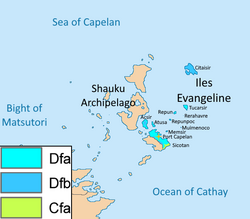 Map of Iles Evangeline and its climate classifications | |
| Candidate Jurisdiction for BORA Inclusion | |
| Capital | Port Capelan |
| Government | |
| • Type | Pre-democratic military governorate |
| • Body | Council of Colonels |
| • Prefect Plenipotentiary | Rachelle-Evangeliste Vanchamps d'Elisioile |
| Area | |
| • Total | 25,666.78 km2 (9,910.00 sq mi) |
| Population (2026) | |
| • Total | 1,485,556 |
| • Density | 58/km2 (150/sq mi) |
| Demonym(s) | Evangeliennes |
Iles Evangeline, officially the Candidate Jurisdiction for BORA Inclusion of Iles Evangeline is a territory of Burgundie. Previously owned by Varshan which governed it as part of its Shauku Islands Province until its forces were expelled in 2021 by a joint Daxo-Alstinian invasion after which it was transferred to Daxiaese control before being sold to Burgundie in 2028.
Etymology
Named for Crown Princess Amelia.
Geography
Geology
The Iles Evangeline make up the northeastern cluster of islands in the Shauku Archipelago main island that is divided between Sotsial and Iles Evangeline is
- Citaisir: highest island, northern most island, 9,194.458 sqkm
- Tucarsir: seal island, 1,450.39 sqkm
- Repun: the offshore, 362.598 sqkm
- Rerahavre: wind harbor, 25.8999 sqkm
- Repunpoc: the lower offshore, 103.6 sqkm
- Muimenoco: winnowing woman 38.8498 sqkm
- Memsir: the island of springs 77.6996 sqkm
- Atusa: the naked one, 751.097 sqkm
- Acsir: little brother island, 4,169.881 sqkm
- Sicotan: Pleasant village, main island, 18,699.71 sqkm
Climate
- Citaisir: Humid subtropical
- Tucarsir: tropical wet and dry
- Repun: tropical wet and dry
- Rerahavre:tropical wet
- Repunpoc: tropical wet and dry
- Muimenoco: tropical wet
- Memsir: tropical wet
- Atusa: tropical wet and dry
- Acsir: tropical wet and dry
- Sicotan:tropical wet in the east and wet and dry in the west
History
Prehistory
-
8000 yr old dug out canoe
Archeological evidence suggests that the Shauku Archipelago was settled around 800,000 years ago by hunter-gatherer peoples who made use of stone and clamshell tools. These people had a mostly plant-based diet with monkey and fish flesh entering their repertoire around 50,000 years ago. Agriculture is first recorded around 15,000 years ago, but it was light due to the thick jungle vegetation. Domesticated dogs and pigs were also evidenced in this period as well. In the 4th century BCE, with the introduction of rudimentary sail technology, to the paddled dugout canoes used by the islanders, the outer islands of the Shauku archipelago became settled. There was light Oyashimane settlement since roughly 200 BC.
Classical Antiquity
Words, words, words. (9th century BC-5th century AD, exact dates determined by you to fit your lore)
Medieval period
Words, words, words. (6th century - early 16th century, exact dates determined by you to fit your lore)
Early modern history
Far East Colony
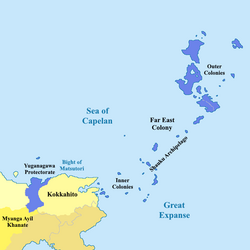
Late modern period
Varshan conquest and rule
Following the abandonment of the Far East Colony in 1817 by the Marialanii Ularien Trading Company the native Oyashi daimyos and ambitious Matsutori mainlanders formed various factions and started fighting to control the territory. One such faction was the Republic of Matsutori, a short-lived Occidental-inspired republic beset by domestic political divisions and ethnic tensions, and foreign territorial encroachments and diplomatic pressure.
During the 1850s, under the of command the Zurg Tezomoc, Varshan initiated a multiyear-long naval expedition to the Shauku Archipelago, thoroughly defeating the Matsutorine forces in the region and rendering Matsutorine control over the islands unfeasible. With the conquest of the archipelago, Varshan had a foothold in the Far East of Audonia and would occupy the islands for the next 170 years.
Contemporary period
Contemporary Varshani rule
Daxo-Alstinian invasion of the Shauku Archipelago
-
Daxian amphibious transport dock passing a sunk Varshani frigate on its final approach to its landing zone.
-
Daxian landing craft resupplying a beachhead on April 13th, 2021.
The Battle of the Shauku Islands was an ancillary engagement during the Final War of the Deluge, fought between March and May of 2021. The Varshani naval contingent on the Shauku Archipelago was considered a liability as it could attack from the rear during the ground invasion of Varshan proper and the allied command determined that it needed to be eliminated. The combined forces of Daxia and Alstin, were tasked to launched an invasion of the archipelago.
The invasion commenced on March 3rd, with a massive naval battle, the First Battle of the Shauku Littoral. The Daxian fleet approached from their southwest stronghold in Cao and the Alstinian fleet arrived from their northwest bases in Oyashima. The Varshani navy, caught off guard by the scale and coordination of the attack, engaged in a fierce but ultimately losing battle, after a two-day running battle, the remaining ships of the Varshani navy, limped out into the Great Expanse. The Daxo-Alstinian forces were able to establish temporary naval dominance of the Shauku littoral, initiating a relentless bombardment of the islands' defenses.
With the Varshani navy crippled and coastal defenses weakened, Daxo-Alstinian forces initiated amphibious landings across the archipelago. The initial landings met with fierce resistance from the Varshani defenders, who were determined to protect the islands. Despite heavy casualties on both sides, the Daxo-Alstinian forces, aided by continuous naval and aerial bombardment, were able to secure small beachheads and begin pushing inland by March 17th. The Varshani defenders used the jungle terrain and guerrilla tactics to launch numerous counterattacks against the Daxo-Alstinian beachheads. The Daxo-Alstinian forces experienced significant setbacks throughout the week of the 21st, with some units being forced back into the sea. In response to the Varshani counterattacks, the Daxo-Alstinian forces intensified their aerial and naval bombardment. The islands' infrastructure, already heavily damaged by the initial assault, was systematically destroyed. The bombing campaign caused widespread devastation and significant civilian casualties, but it also severely weakened the Varshani defenses and made command and control communications extremely difficult, rendering coordinated operations almost impossible. During the first week of April, a number of resupply convoys arrived and the Daxo-Alstinian forces, reinforced and resupplied, renewed their amphibious assaults, determined to gain control of the beaches. The Varshani defenders, although disorganized, lacking a functional central command and depleted of resources and ammunition, continued to resist fiercely. After weeks of bloody fighting, the Daxo-Alstinian forces eventually managed to secure the beaches, establishing a firm foothold on the major islands. With the beaches secured, the Daxo-Alstinian forces began their advance inland. The Varshani defenders, now fighting a desperate rearguard action, retreated into the interior, using the ruined infrastructure to their advantage to confound Daxo-Alstinian armored manevers and to conduct ambushes. The fighting was sometimes even hand-to-hand, with the Daxo-Alstinian forces suffering heavy losses. As the Daxo-Alstinian forces advanced throughout the second week of April, the Varshani navy returned and launched a series of counterattacks in an attempt to disrupt the invasion. These attacks, the Second Battle of the Shauku Littoral, although initially successful in distracting the Daxo-Alstinian advance, were ultimately repelled, with the Varshani navy fighting to the last vessel and aircraft. The battle ended on April 25th when the last of the Varshani submarines was hunted down and destroyed. Despite the setbacks and heavy casualties, the Daxo-Alstinian forces relentlessly pursued the remaining Varshani defenders on land. The fighting continued for two more weeks, with the Varshani forces gradually being isolated and killed. Eventually, after 9 weeks of intense combat, the last Varshani strongholds were overrun, and the islands were declared secure.
In the aftermath, Daxia and Alstin divided the archipelago between them. The southern islands, fell under Alstinian control and the northern islands were occupied by Daxia. The Alstinians quickly established a military administration in their sector, focusing on restoring order and rebuilding infrastructure. They invested in the islands' agricultural lands and established naval bases to protect their trade routes and project power into Audonia. The initial occupation was met with pockets of resistance, with a guerrilla movement, comprised of former Varshani soldiers and disgruntled civilians, launching sporadic attacks against Alstinian forces and infrastructure projects. The Daxians prioritized the exploitation of the islands' mineral wealth, establishing mining operations and industrial complexes. They also constructed military fortifications, transforming the northern islands into a formidable bulwark against potential Varshani counterattacks. They forcibly deported the vast majority of the Vasrhani almost immediately and have few cases of resistance
Daxian military rule
A joint naval invasion by Alstinian and Daxian forces pushed Varshan's forces from the islands and brought an end to its rule there. A period of popular resistance driven by Arzalist priests followed. The Daxian military enacted brutal mass reprisals and deportations that however succeeded in quieting down the situation. Civilian Varshani administrators were summarily dismissed, Arzalist shrines shuttered and all public gatherings of over three people prohibited. Whatever produce was imported from the mainland was requisitioned by the army to supplement its rations, the locals were introduced to a new diet consisting of disgusting aspic food rations courtesy of Agario. Four months after introduction, there was a riot at a food distribution center in which twenty tons of aspic rations were set on fire. Daxian rule of the unruly islanders was becoming more expensive and less advantageous than previously thought.
Handover to Burgundie
Liyu, was transferred to Burgoignesc administration on November 17th, 2028 as a reparation for the loss of Ayermer during the Second Great War which until that point had remained a major sticking point in the relationship between Burgundie and Daxia to the point that both countries, as a matter of administrativia, remained technically at war until the handover of Liyu and the signing of the Instrument of the Formalization of the Cessation of Hostilities Stemming from the Global Conflicts of the 1930s and 1940s.
A respectful ceremony between outgoing District Chief, Gong Farbo, and incoming Prefect Plenipotentiary, Rachelle-Evangeliste Vanchamps d'Elisioile and their retinues of diplomats, marines, sailors, and administrative personnel after which its name was changed to Iles Evangeline after Crown Princess Amelia, of Burgundie who helped to broker the deal.
Government
| This article is part of a series on the |
| BORA |
|---|
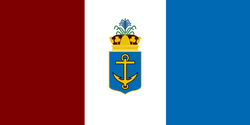 |
| Statistics |
|
| Key topics |
| Provinces |
|
Burgundie portal |
Iles Evangeline is part of the Burgoignesc Overseas Territory Assembly's Polar Burgundies geographic designation. Burgoignesc Overseas Territory Assembly is a constituent country equivalent of Burgundie with its own assembly, prime minister, budget, and laws. Burgundie's national governmental influence is limited to subsidies, education, and security, however, its financial and cultural institutes cast a long shadow across Iles Evangeline.
Iles Evangeline is a candidate constituent province within Burgoignesc Overseas Territory Assembly with its own semi-elected Governor-Epistates, representative legislative body, and court system.
Iles Evangelineures are Burgoigniacs/Burgoignix with complete civil and economic rights, and citizenship (political rights) under the same federal service criteria as all residents of Burgundie. Burgoignesc is the official language but Oyashima and Burgoignesc are both in use.
Provincial executive
The provincial executive is the Governor-Epistates. Three candidates are elected by a single transferable vote election held every 5 years, the three candidates are presented to the Court of St. Alphador and the next Governor-Epistates is chosen from these candidates. If the citizenry rejects the selection, a run-off election is held with the remaining two candidates.
Provincial legislature
Like the Citizens Court of the National Assembly (Burg. La Assemblee de Ciutadans de l'Assemblee Nacional, ACAN), The Iles Evangeline Citizen's Court of the Provincial Assembly is a unicameral legislator. It makes provincial law, has the power of the provincial purse, and has the power of impeachment, by which it can remove sitting members of the provincial government. The Assembly has three seats for each province, one for the Burgoignesc Overseas Territory Assembly's Iles Evangeline liaison, 3 for the clergy, 3 seats reserved for municipal leaders, and 3 for a rota of private business leaders. On 6 occasions throughout the year 3 more seats are opened to the public to debate topics that are not on the annual legislative agenda.
Administrative divisions and local governance
Military
Military installations
Iles Evangeline is home to two military bases, Fort St. Genevieve, jointly operated by Navy of Burgundie and the Revenue Guard, and Fort St. Ambrose, operated by the Foreign Legion.
Fort St. Genevieve
| Fort St. Genevieve Northern Cathay Joint Maritime Patrol Station | |
|---|---|
| | |
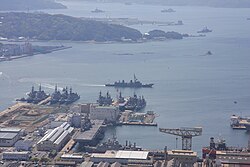 | |
| Site information | |
| Owner | Burgoignesc Security Forces |
| Operator | Navy of Burgundie |
| Controlled by | Burgoignesc Borealis Combined Forces Command, Western Sector |
| Condition | Operational |
| Site history | |
| Built | YEAR |
| Garrison information | |
| Occupants | Navy
|
Fort St. Ambrose
| Fort St. Ambrose Garrison of the Transitional Detachment of the Foreign Legion and National Gendarmerie in Iles Evangeline | |
|---|---|
| | |
 | |
| Site information | |
| Owner | Burgoignesc Security Forces |
| Operator | Army of Burgundie |
| Controlled by | Burgoignesc Borealis Combined Forces Command, Western Sector |
| Condition | Operational |
| Site history | |
| Built | YEAR |
| Garrison information | |
| Occupants | Foreign Legion
Treaty Observation and Implementation Corps of Burgundie
|
Emergency response
National Gendarmerie of Burgundie, Overseas Gendarmerie, Borealis Command
Revenue Guard, Grand Station Orxital
Society
| This article is part of a series on the |
| Culture in Burgundie |
|---|
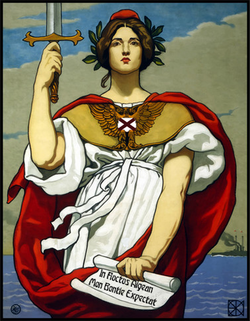 |
| Society |
| Arts and literature |
| Other |
|
Burgundie portal |
Ethncity according to the official census (2020)
Religion, ethnicity, language, education, attitudes and worldview, kinship and family, cuisine, arts, literature, architecture, sports, symbols
The ethno-racial makeup of Iles Evangeline has changed considerable over the years. Originally lightly settled by peoples from Oyashima since around the year 200 CE, the islands never held more than a few thousands at their population peak. The disastrous aftermath of the Tezomoc Expedition for the Oyashima fleet led to an almost complete exodus from the islands, with Varshan bringing in thousands of its own laborers to work on the many mines on the islands in the late 19th century. This demographic dominance by peoples of Varshan origin continues to the modern day, altough the brief Daxian rule and now the Burgoignesc administration has resulted in the return of some Oyashimans along with new Daxiaese, Rusanan, and Bergendii arrivals. Daxiaese and Rusanan residents were offered a stipend to leave the island upon the transfer of power to Burgundie.
Language
The "native" language of the Shauku Archipelago is Ainu.
Religion
Economy

The economy of the islands is relatively developed and varied as they possess significant natural resources that the Varshani state sough to develop. Iles Evangeline have significant reserves of copper and thus strip mining of these is a major economic activity with an estimated production of four hundred thousand metric tons extracted in 2021. All of Iles Evangeline's copper mines are now under the control of the Department of Trade which is introducing the use of newer technology to increase copper production. Also present are large deposits of blue limestone and diorite which were highly valued by the Varshani for use in the construction of their monuments and temple complexes. So important were these materials to the mainland that most of the mines were nationalized and placed under the direct control of state run Arzalist foundations that directed the materials specifically to temples under construction in the mainland. Another important economic activity is the cultivation of aloe vera, which is used in Varshan's traditional medicine. Under Varshan rule, almost one third of the island's arable surface is dedicated to planting aloe fields. Tourism from mainland Varshan began to experience moderate growth and a few resorts catering to the upper castes were opened in the late 2000's. The partial restoration of the Blood Fane of Buruso saw a marked uptick in arzalist pilgrimages to the site so much that the Varshan Control Commission lodged at formal complaint with Daxian authorities, fearful of arzalist proselytism. Burgundie has banned Varshani travellers all together.
Standard of living
Employment
Burgundie's high emphasis on education translates to a particularly educated and skilled workforce, leading to lower unemployment compared to less educated countries in Audonia. The islands' economic diversity cushions against overreliance on any single industry, which has demonstrably made the island more resilient during downturns. Since Burgundie strives for Total Economic Engagement and espouses equal rights and opportunities regardless of gender, race, ethnicity, ability, or background, Iles Evangeline benefits from improved access to education and training, impacting employment prospects across various fields.
Agriculture
Agricultural production, primarily of aloe vera, wheat, soybeans, potatoes, sugar beets, onions, pumpkins, corn, raw milk, and beef, Guar and guar gum
Tourism and hospitality
Tourism has currently been severely restricted as the Treaty Observation and Implementation Corps has set about to reconstitute the government and economy of the Iles Evangeline. But early surveys point to winter sports being a primary draw with skiing/snowboarding and dog sledding being primary activities. Thermal baths and locally brewed beer are expected to be a strong draw for the après-ski set.
Resorts
Cruises
Recreation
Key tourism and hospitality companies
Logging/Mineral extraction
copper and thus strip mining of these is a major economic activity with an estimated production of four hundred thousand metric tons extracted in 2021. All of Iles Evangeline's copper mines are now under the control of the Department of Trade which is introducing the use of newer technology to increase copper production. Also present are large deposits of blue limestone and diorite
lead, manganese, silver, zinc,
Paper milling
Mining
Drilling
Fishing
Fishing and fisheries
Distant-water fishing fleet
Local commercial fishing
Aquaculture
File:Lüshunkou Pearl Aquaculture旅顺口真珠養殖065399.jpg|Pearl farming
Pisciculture
Pisciculture in the Iles Evangeline is focused mostly on the raising of chum salmon, Sockeye salmon, and Dolly Varden trout. Artisanal fishing is the only allowable form of pisciculture in Iles Evangeline and it produces about 1-200 tonnes of fish each year.
Since the Burgoignesc administration began there has been demand for investment in modernization of pisciculture across the Iles Evangeline to ramp up exports of Sockeye salmon specifically both farmed and wild caught. A team of experts are searching for suitable sites for copper alloy sea cages for the sockeye.
The pisciculture sector, like all other sectors in the Iles Evangeline are severely underdeveloped in the Occidental perspective. The Burgoignesc Ministry of Economy, Finance, and the Recovery's Department of Trade and the Ministry of Agriculture and Food have established a Joint Office of Evangeline Economic Development and Food Security to identify "locally acceptable avenues to increase development and output for both local and Metropolitan consumption".
Mariculture
Mariculture Shrimp and saltwater clams
Artisanal/heritage industries
Science and research
Manufacturing
The native Ainu people of Shauku Archipelago are famous for creating a type of boat called the pinisi and Burgundie had reinvested in making these boats is a cottage industry for the islanders so that they can have their own indigenous deep-sea fishing fleet and local trading fleet with Sotsial and Oyashima. These ships are carries seven to eight sails on two masts, arranged like a gaff-ketch with what is called 'standing gaffs' — i.e., unlike most Occidental sailing ships using such a rig, the two main sails are not opened by raising the spars they are attached to, but the sails are 'pulled out' like curtains along the gaffs which are fixed at around the centre of the masts. This allows the gaff to be used as a crane to embark and disembark up to 200 tonnes of breakbulk cargo. These ships usually carry timber, local produce, and commodities. Since the annexation of the islands by Burgundie there have been some converted to tourism crusiers and day trippers who h have proven wildly popular. The construction itself is also a tourist attraction.
Creative industries
Sports and leisure
Trade
| Port Capelan | |
|---|---|
| Location | |
| Country | |
| Details | |
| Opened | YEAR |
Port Capelan is a small container port that can accommodate two feeder sized ships at once. It is used to export the agricultural goods from the island but also to supply the locals with sustenance since the island is not self-sufficient.
Trade is handled throught the Shauku Island Trading Company (SITC), a joint stock company that is owned 20% by Alstin, 20% by Burgundie, 20% by O’Shea Container Shipping, and the remaining shares are publically traded. The SITC handles the imports and exports from Iles Evangeline and Alstinian Sotsial. It runs a regular route from Equitorial Ostiecia and Deralveca City, Alstin.
Transshipment
Main article: Transshipment
Customs and tariffs
Main article: Customs
Infrastructure
Maritime
There is also the Iles Evangeline-Korell ferry which makes one round trip every week with a stop at Ankae in Metzetta. Marine Highway ferry system to connect the islands together with Sotsial and Oyashima.
Lighthouses
Rail
The passenger rail in Iles Evangeline is being completely rebuilt to implement standard gauge and establish greater connectivity for service. This work is planned to be completed by 2039 at which point it will become a unique rail service provider, a body that has not yet been formed.
Roads
Air
Iles Evangeline is accessible through a connecting flight from Anjiro International Airport on the Alstinian Sotsial. Capelan Regional Airport (CRA) is a state-run public airport situated in the main island, it has two runways with an asphalt surface measuring 1,524 x 46 m. For the 12 month period ending on March 13 2025,the airport had a total of 15,032 flights and an average of 18 daily flights. A new runway and renovated passenger areas are planned for 2029.
Energy and electricity
Agrinergie
Main article: Agrivoltaics

















